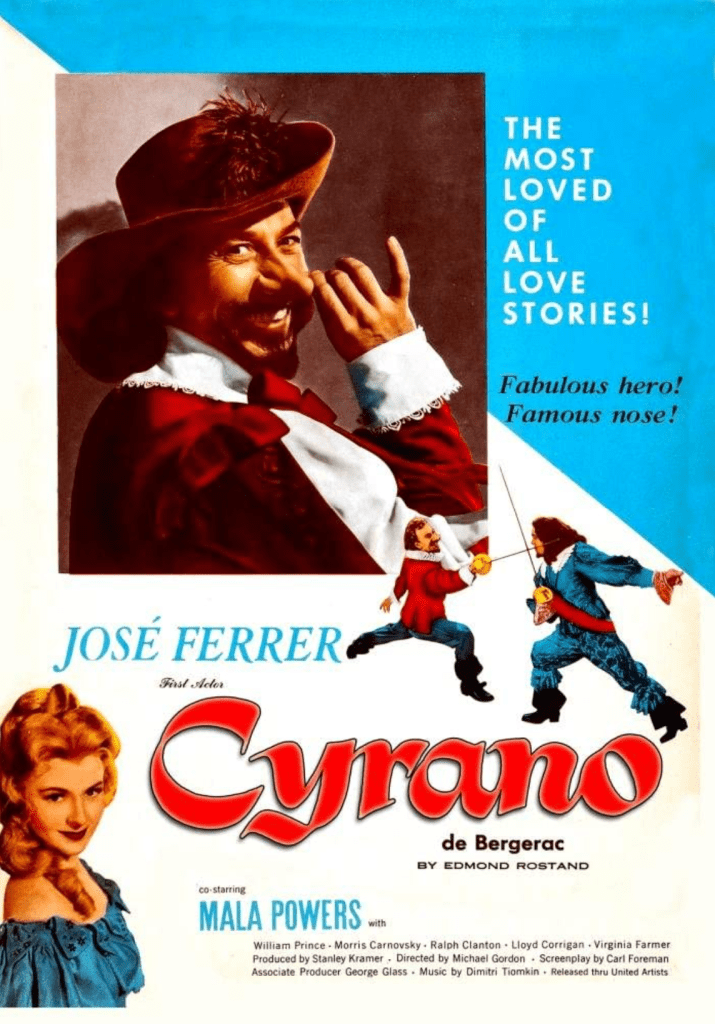Two years ago, when I reviewed the 1990 adaptation of Cyrano de Bergerac, I was given a movie recommendation by Le from Crítica Retrô. That recommendation was Cyrano de Bergerac’s 1950 adaptation! Like any film suggestion I’m given, I wanted to make the time to watch and/or review this title. The opportunity finally came this month! March’s film for Genre Grandeur is Oscar Nominated /Winning Films. From what I’ve gathered, 1950’s Cyrano de Bergerac was nominated for and won an Oscar for Best Actor. Then I discovered The Bonnets and Bustles: Costume Blogathon. While thinking about what to write for the event, I realized Cyrano de Bergerac would be an eligible topic. Therefore, I’ve decided to review this movie for both blogathons!

Things I liked about the film:
The acting: I am not familiar with José Ferrer’s filmography. Despite this, the one word I would use to describe his performance in Cyrano de Bergerac is confident! The confidence within José’s portrayal helped him stand out against Gérard Depardieu’s portrayal in the 1990 adaptation. This confidence was also a consistent component that made Cyrano a force to be reckoned with! Toward the beginning of the film, Cyrano engages in a duel at the local theater. Throughout this scene, the protagonist speaks eloquently and with sophistication. He holds his own in the duel, with his posture and skills showing the audience that he knows what he’s doing. But this aforementioned confidence never comes across as cocky. Instead, Cyrano is presented as being sure of himself, despite his flaws and imperfections.
Christian de Neuvillette is portrayed by William Prince. What makes his portrayal stand out from Vincent Perez’s performance is how Christian came across as a hopeless romantic. This can be seen when he visits Roxane one evening. During their conversation, Christian becomes tongue-tied. He struggles to find the right words without Cyrano’s help. But the passion he feels for Roxane is displayed on his face. William’s body language also proved how much his character wanted to be with Roxane. Speaking of Roxane, let’s talk about Mala Powers’ performance. In this adaptation of Cyrano de Bergerac, Roxane was mesmerized by the romantic words of Cyrano and passionate gestures of Christian. The balcony scene is a perfect example. As Christian quotes Cyrano’s poetry, Roxane is overcome by her feelings. Her voice contains emotion, expressing through words what is in her heart. Roxane’s body language longs for a romantic embrace, as she searches in the night for the one she loves. Mala’s performance is one of the reasons why that scene packed such a punch!
The sword fights: In this adaptation of Cyrano de Bergerac, there were some exciting sword fights! Part of that excitement comes from the quality of the choreography! As I said earlier in this review, I talked about Cyrano’s involvement in a duel at a theater. While that fight was captivating to watch, that wasn’t the only fight to feature good choreography. One evening, Cyrano guards a local baker on his way home. Along the way, they become surrounded by the baker’s enemies. Throughout this scene, the fight choreography is sharp, fast-paced, and precise. These elements allow the fights to appear professional, like the actors involved are taking this part of their performance seriously. What also made these fights exciting was the different camera angles used to capture the shots. The various angles let the audience witness the fights from different perspectives.
Cyrano and Roxane’s interactions: Because Cyrano and Roxane have known each other prior to the events of the film, they have a pre-existing friendship. The on-screen camaraderie between José Ferrer and Mala Powers made my experience watching Cyrano and Roxane’s interactions enjoyable! During these interactions, Roxane and Cyrano share a genuine tenderness that comes across as sweet and good-natured. At the bakery one day, Cyrano learns Roxane has developed feelings for Christian. Even though he is not pleased to learn this news, Cyrano seems to place Roxane’s happiness before his own. Later in the film, when Roxane is sharing Christian’s “poetry” with Cyrano, Cyrano adopts a protectiveness toward Roxane. Meanwhile, Roxane doesn’t miss a beat. She recites Cyrano’s words in a heart-felt way, her vocal inflections indicating how much she enjoys the words. Interactions like this one make me wish Roxane appeared more in the film.

What I didn’t like about the film:
An orange tint: Throughout the film, the picture was coated in an orange tint. Though this tint was not consistently present, it was somewhat distracting. The colors of the costumes and set design appeared faded because of this tint. However, I’m not sure if the tint was caused by the use of lighting or the cinematic technology of the ‘50s.
Few interactions with Christian and Roxane: A major plot-point in Cyrano de Bergerac is the growing relationship between Roxane and Christian de Neuvillette. What makes this plot-point so memorable is how Roxane is smitten by Christian’s words, which were composed by Cyrano. In this adaptation of the story, Christian and Roxane don’t spend much time together. Looking back on the film, I can think of only three scenes featuring their interactions. Because of Roxane and Christian’s limited time together, Mala and William’s on-screen chemistry wasn’t as strong as it could have been.
No build-up to the war storyline: When I reviewed the 1990 adaptation of Cyrano de Bergerac, I wrote about the war storyline that dominated the movie’s second half. In my review, I said this storyline pulled a “bait and switch” with the film’s overall tone. I also said the build-up toward the war and the reasoning behind it felt too “inside baseball”. While there is a war in the 1950 adaptation, there is no build-up or reason for this event. It feels like the war was placed in the middle of the movie for the sake of providing more action in the story. I still have not read this story’s source material, so I don’t know the historical context of this text. However, some build-up and/or a reason for the war would have been appreciated in the 1950 adaptation.

My overall impression:
A singular adaptation of any story is not the “end all, be all”. Part of that is due to film itself being so subjective. Cyrano de Bergerac from 1950 is the second adaptation of this narrative I’ve seen. But I ended up liking it about as much as the 1990 version. 1950’s Cyrano de Bergerac follows similar beats to 1990’s adaptation. But the movie itself is distinct enough to stand out on its own. The differences in the 1950 version added enjoyment to the overall project, such as the sword fights. But, like the 1990 film, the 1950 project had its flaws. I will say Cyrano de Bergerac from 1950 is the more accessible movie of the two. But no matter which version you choose, the romance, wit, and ways with words are still the same.
Overall score: 7.5 out of 10
Have you seen any adaptation of Cyrano de Bergerac? If so, which one is your favorite? Let me know in the comment section!
Have fun at the movies!
Sally Silverscreen

Pingback: The Bonnets and Bustles: Costume Blogathon has arrived! – Pale Writer
I hadn’t heard of this adaptation before you wrote about. It’s interesting that this story has been adapted quite a few times, and again this year starring Peter Dinklage. I enjoyed how you spoke about both the strengths and the weaknesses of the film. Thank you for contributing to our Blogathon! 😊
LikeLiked by 1 person
Thanks for reading my review, Pale Writer! I’m wondering if ‘Cyrano de Bergerac’ is currently in the public domain? That would explain why this story has received several adaptations. Thanks also for hosting the Bustles and Bonnets Costume Blogathon! I’m hosting a blogathon as well. Here’s the link if you’re interested:
LikeLiked by 1 person
I saw the 1990 version for a film class, and I agree with you about the 1950 version being more accessible. It’s really hard to take notes and read subtitles at the same time. 🙂
LikeLiked by 1 person
Thanks for checking out my review, Rebecca! As I said to Pale Writer, ‘Cyrano de Bergerac’ has been adapted several times. While there is an argument to be had about unnecessary remakes, having more than one adaptation of ‘Cyrano de Bergerac’ provides something for everyone.
LikeLiked by 1 person